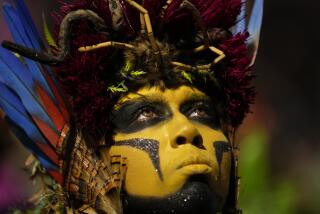Deja View to Tragedies of America Past
- Share via
In the late 1980s, Geoffrey O’Connor, a New York-based documentary filmmaker, journeyed to the Amazon rain forest to report on what, after 500 years of conflict between whites and native peoples, had become a depressingly familiar story.
In defiance of Brazilian law, 45,000 gold miners had poured into the territory of the Yanomami tribe. They brought malaria and other diseases. They tore huge muddy pits in the ground with generator-powered hoses. They polluted the rivers with mercury during the ore-separation process. As in our own Wild West, guns were everywhere, violence went unpunished, and the Yanomami usually got the worst of it.
With his translator and soundman, a smooth-talking Rio de Janeiran nicknamed “the Wolf,” O’Connor visited villages, clinics, missions and vast estates worked by near-slaves and patrolled by private armies of pistoleiros. He touched down at squalid airstrips where drunks and beggars mingled with Brazilian entrepreneurs who flashed big gold nuggets on neck chains and aggressively asserted their rights to unregulated profits.
Similar scenes must have once been common in California. According to one of the historical sources O’Connor quotes--”Native American Testimony,” edited by Peter Nabokov in 1991--”the gold rushers and homesteaders . . . were responsible for murdering over 50,000 Native Americans between 1848 and 1870 alone.”
The difference is that in the 19th century there weren’t so many of those pesky media people like O’Connor around, linked to a worldwide audience and forcing even the most hard-bitten miners into clumsy attempts at spin-doctoring. Nor did the cause of indigenous Californians happen to coincide with a burgeoning second issue--ecological consciousness, the suddenly perceived value of the rain forest itself.
But that’s what happened in Brazil while O’Connor was there. The military government gave way to civilian rule. The murder of labor organizer Chico Mendes by pistoleiros aroused international indignation. British rock star Sting organized a conference in the rain forest, a precursor to the celebrity-studded Earth Summit in Rio in 1992.
The ending seemed to be a happy one. Most of the miners were evicted. Many Yanomami died of malaria, but fewer than had been feared. The Kayapo tribe was granted a tract of forest the size of Switzerland. The level of violence declined.
Then the reporters and photographers drifted on to the next story--in Bosnia, this time--leaving O’Connor unsure exactly what had happened.
The Brazilians, he had learned, weren’t one-dimensional villains. Many of the miners were desperately poor, fleeing rural peonage or city slums. Politicians, testy about Brazil’s long subordinate relationship to the United States, were understandably worried that the Amazon region, in the name of ecology, might come to be ruled, in effect, by foreign powers.
Nor did the Indians always live up to our sentimentalized images of them (a reversal of the demonic images we used to have). Some bartered away logging and mining rights. Paulinho Payakan, a Kayapo leader once touted by Parade magazine as “the man who would save the world,” got into a drunken brawl that resulted in hostile authorities charging him with rape.
And, O’Connor started wondering, what about the public that consumes those images? What about the media, who create them? “With our pens, laptops and pictures, we take reality and transform it to fit our belief system.” It’s a shamanistic ceremony, he says, as “complex and significant as any . . . being acted out in those secluded forest villages”--and just as emotion-laden and fundamentally primitive.
These doubts, and the historical perspective O’Connor adopts, are the chief virtues of this book, along with his sharp, visual prose. Despite the positive events he reports, he fears that “the same cycle . . . of tragic misunderstandings” that began with Columbus will continue, because the cultural gap is greater than even the most sympathetic whites imagine. He says flatly: “No one has ever been able to get around it.”
More to Read
Sign up for Essential California
The most important California stories and recommendations in your inbox every morning.
You may occasionally receive promotional content from the Los Angeles Times.










